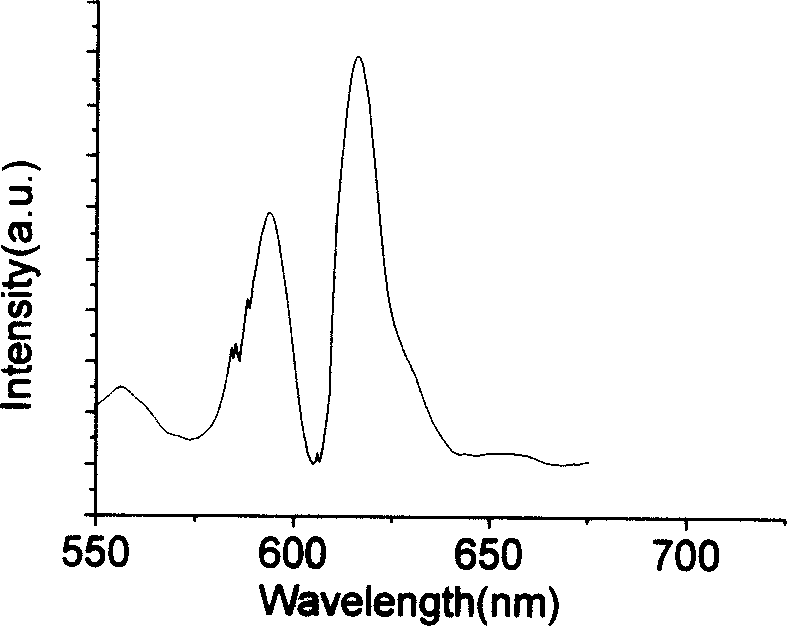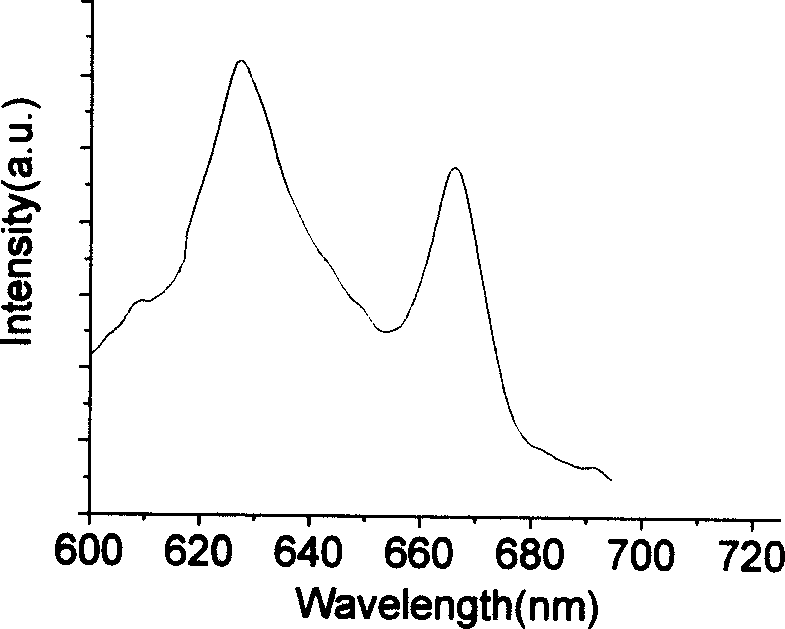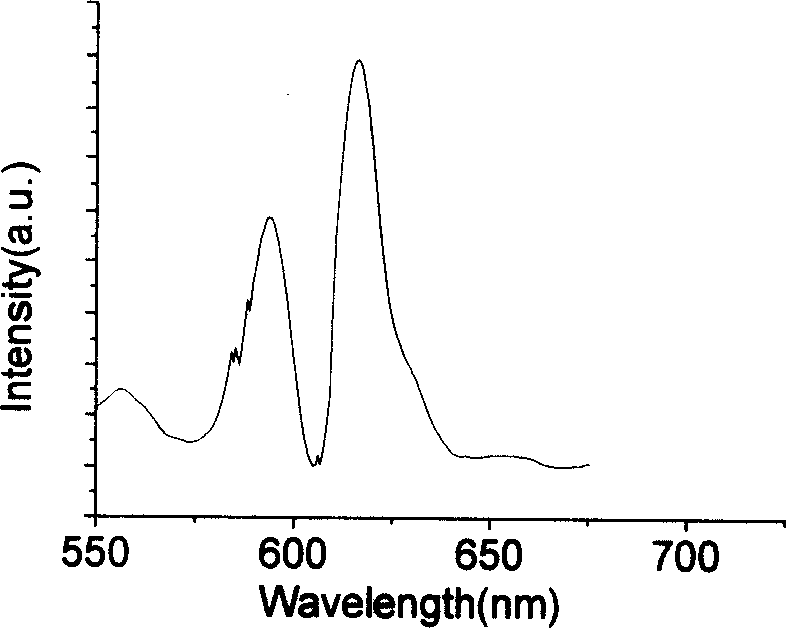Garnet type gadolinium aluminate based fluorescent powder and method for making same
A gadolinium aluminate-based, garnet-type technology, applied in chemical instruments and methods, luminescent materials, etc., can solve the problems of high heat treatment temperature, easy introduction of impurities, etc., and achieve uniform particle size distribution, simple and easy process, and luminescence. strong effect
- Summary
- Abstract
- Description
- Claims
- Application Information
AI Technical Summary
Problems solved by technology
Method used
Image
Examples
Embodiment 1
[0016] Get 18.75g aluminum nitrate (Al(NO 3 ) 3 9H 2 O), 5.439g gadolinium oxide (Gd 2 o 3 ), 0.1056g europium oxide (Eu 2 o 3 ), 33.4g citric acid, and a sufficient amount of concentrated nitric acid were dissolved in deionized water, stirred to form a uniform solution and adjusted to a pH value of 7. The beaker containing the solution was placed on a magnetic stirrer, heated to 70°C and kept stirring, and a sol was formed after several hours. Continue stirring and heating until a clear gel forms. Put the gel into a box furnace and heat it to 400 °C to form a gray-black precursor powder. The precursor powder is then calcined at 900°C for 1.5 hours to obtain Gd 3 Al 5 o 12 :Eu(5%molGd) pale pink final product. figure 1 for Gd 3 Al 5 o 12 :Eu 3+ Fluorescence spectra of nanopowders excited by ultraviolet light, indicating that the luminescent ion Eu 3+ It enters the GAG lattice in the form of solid solution, and emits red fluorescence under the excitation of ul...
Embodiment 2
[0018] Get 18.75g aluminum nitrate (Al(NO 3 ) 3 9H 2 O), 5.439g gadolinium oxide (Gd 2 o 3 ), 0.1016g praseodymium oxide (Pr 6 o 11 ), 33.4g citric acid, and a sufficient amount of concentrated nitric acid were dissolved in deionized water, stirred to form a uniform solution and adjusted to a pH of 3. The beaker containing the solution was placed on a magnetic stirrer, heated to 75°C and kept stirring, and a sol was formed after several hours. Continue stirring to form a transparent gel. Put the gel into a box furnace and heat it to 450°C to form a gray-black precursor powder, which is calcined at 1300°C for 2 hours to finally obtain Gd 3 Al 5 o 12 :Pr(5%molGd) pale pink final product. figure 2 for Gd 3 Al 5 o 12 :Pr 3+ The fluorescence spectrum of the nanopowder under ultraviolet light excitation shows that the luminescent ion Pr enters the GAG lattice in the form of solid solution, and emits red fluorescence under the excitation of ultraviolet light (254nm)....
Embodiment 3
[0020] Get 18.75g aluminum nitrate (Al(NO 3 ) 3 9H 2 O), 5.493g gadolinium oxide (Gd 2 o 3 ), 0.1056g europium oxide (Eu 2 o 3 ), 0.0103g cerium oxide (CeO 2 ), 33.4g citric acid, and a sufficient amount of concentrated nitric acid were dissolved in deionized water, stirred to form a uniform solution and adjusted to a pH of 5. The beaker containing the solution was placed on a magnetic stirrer, heated to 80°C and kept stirring, and a sol was formed after several hours. Continue stirring to form a transparent gel. Put the gel into a box furnace and heat it to 450°C to form a gray-black precursor powder, which is calcined at 1200°C for 1.5 hours to finally obtain Gd 3 Al 5 o 12 :Eu, Ce light pink final product. image 3 for Gd 3 Al 5 o 12 : Fluorescence spectra of Eu, Ce nanopowders excited by ultraviolet light.
PUM
 Login to View More
Login to View More Abstract
Description
Claims
Application Information
 Login to View More
Login to View More - Generate Ideas
- Intellectual Property
- Life Sciences
- Materials
- Tech Scout
- Unparalleled Data Quality
- Higher Quality Content
- 60% Fewer Hallucinations
Browse by: Latest US Patents, China's latest patents, Technical Efficacy Thesaurus, Application Domain, Technology Topic, Popular Technical Reports.
© 2025 PatSnap. All rights reserved.Legal|Privacy policy|Modern Slavery Act Transparency Statement|Sitemap|About US| Contact US: help@patsnap.com



